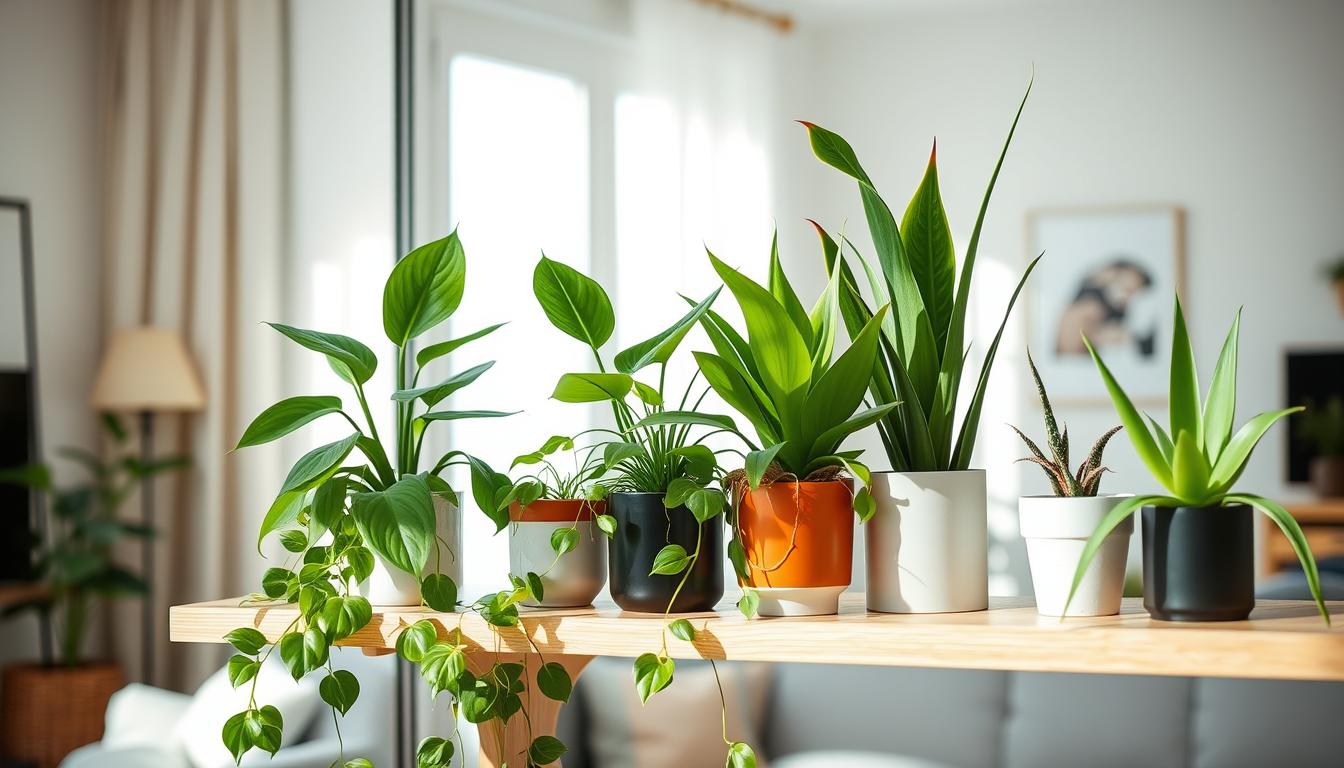In today’s world, we often forget the value of natural elements in keeping our homes healthy. But, research shows that some indoor plants can clean the air we breathe. This article looks at 10 easy-to-care-for houseplants that make your space look good and air cleaner.
From the tough Snake Plant to the elegant Boston Fern, these plants are proven air cleaners. The NASA Clean Air Study backs their effectiveness. By knowing how to care for them, you can easily add these air purifiers to your home or office. This makes your space healthier and more welcoming.
Understanding Indoor Air Quality and Plant Benefits
Keeping our indoor air clean is key to our health. Plants help a lot in this area. They use phytoremediation to remove harmful volatile organic compounds (VOCs) like formaldehyde, benzene, and trichloroethylene from the air.
How Plants Filter Indoor Air Pollutants
Plants are amazing at cleaning the air. They soak up bad stuff through their leaves and roots. This natural process breaks down harmful compounds into safer parts that become part of the plant itself.
NASA Clean Air Study Findings
The NASA Clean Air Study from the late 1980s was a big deal. It showed that some plants are super good at cleaning the air. They can remove formaldehyde, benzene, and trichloroethylene from our homes.
Common Indoor Air Contaminants
- Volatile Organic Compounds (VOCs): These come from things like paints, cleaners, and furniture. They’re bad for our health.
- Formaldehyde: It’s in many things we use, like furniture and building materials.
- Benzene: Found in fuels and solvents, it’s a cancer-causing chemical that can be in our homes.
- Trichloroethylene: Used in some industrial and household products, it’s another indoor pollutant.
Adding air-purifying plants to your space can help fight these indoor pollutants. This makes your home or office a healthier place to be.
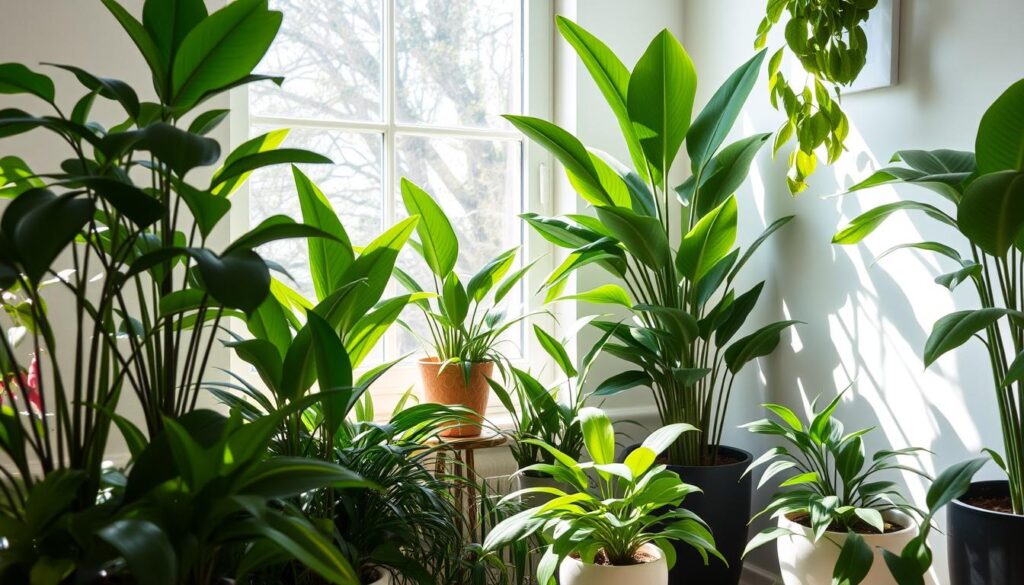
Snake Plant (Sansevieria): The Bedroom Air Purifier
The Sansevieria trifasciata, or mother-in-law’s tongue, is a houseplant that cleans the air. It’s perfect for bedrooms, where it can improve the air quality while you sleep.
This plant is special because it makes oxygen even without sunlight. It’s one of the few plants that does this. So, it’s great for bedrooms, helping to make the air fresher for a good night’s sleep.
The snake plant also removes harmful formaldehyde from the air. Formaldehyde is found in furniture, carpets, and some cleaning products. By getting rid of this toxin, the Sansevieria trifasciata makes your bedroom air safer.
Snake plants are easy to care for, making them perfect for beginners or busy people. They need little water and care. Their striking leaves and low-maintenance nature make them a top choice for bedrooms.
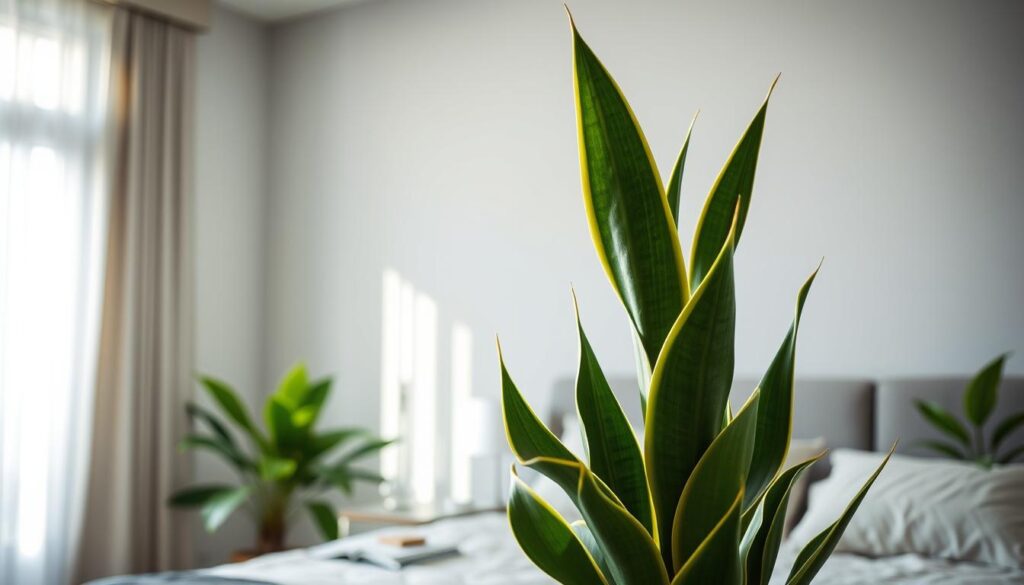
“The snake plant is a true ally in the fight for clean, healthy indoor air. Its ability to produce oxygen at night and remove formaldehyde make it an indispensable addition to any bedroom.”
Peace Lily: A Powerful Air-Cleaning Champion
The Peace Lily, known as Spathiphyllum, is a top indoor plant for cleaning the air. It can remove harmful toxins like benzene and trichloroethylene. This makes it a hero for improving indoor air quality.
Optimal Growing Conditions
Peace Lilies grow well in different light levels, from bright to low. They need well-drained soil and should not be watered too much. Let the soil dry a bit before watering again.
Toxin Removal Capabilities
The NASA Clean Air Study showed Peace Lilies are great at removing benzene and trichloroethylene. These are common pollutants found indoors. Adding a Peace Lily to your space can make it healthier and cleaner.
Care Requirements
Peace Lilies are easy to care for. They need occasional watering and should be pruned to remove dead leaves. With proper care, they can keep the air clean for many years.
If you want to improve air quality in your home or office, consider a Peace Lily. It’s a low-maintenance choice that’s effective at purifying the air. Its ability to adapt to different light conditions makes it a top pick among Spathiphyllum and other low-light plants.
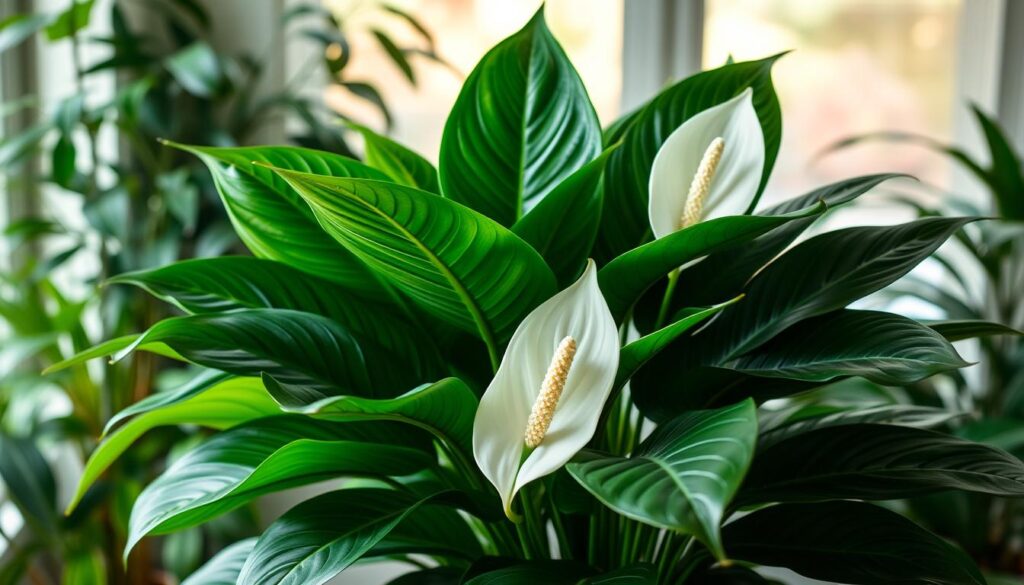
Spider Plant: Perfect for Beginners
The Chlorophytum comosum, also known as the Spider Plant, is great for cleaning the air indoors. It’s especially good at removing xylene, a common pollutant. This makes it perfect for those wanting cleaner air at home or work.
The Spider Plant is easy to care for, making it great for beginners. It’s easy to propagate too. The plant grows “spiderettes” or offsets that can be split and replanted, keeping your space full of fresh greenery.
Not only does it clean the air, but it also looks good. Its long leaves cascade beautifully in hanging baskets. It can grow well in many light conditions, from bright to shaded.
| Benefit | Details |
|---|---|
| Xylene Removal | The Chlorophytum comosum is highly effective at removing xylene, a common indoor air pollutant. |
| Easy Propagation | The Spider Plant readily produces “spiderettes” or offsets that can be easily separated and repotted. |
| Versatile Growth | The Spider Plant thrives in a wide range of indoor conditions, including bright, indirect light and more shaded areas. |
Whether you’re new to plants or have lots of experience, the Spider Plant is a great choice. It improves air quality and adds beauty to your space.
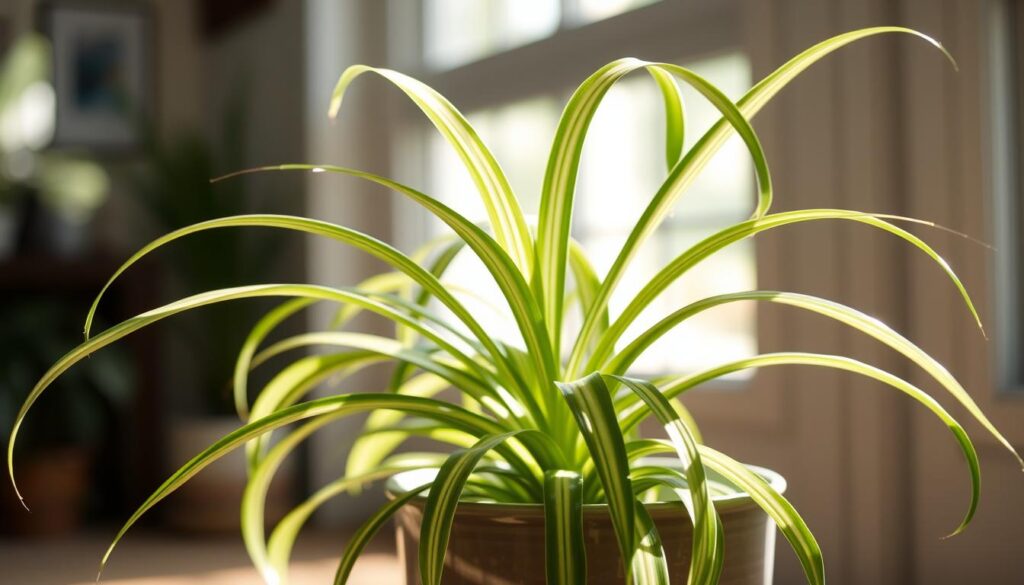
10 Low-Maintenance Indoor Plants That Purify the Air
Creating a healthy indoor space is easier with air-cleaning houseplants. These plants not only add greenery but also remove harmful toxins. We’ll look at 10 low-maintenance plants NASA recommends for their air-cleaning abilities.
Selection Criteria
We chose these plants for their ease of care and air-purifying skills. They’re perfect for those new to plant care. These air-cleaning houseplants need little attention and can thrive in various indoor settings.
Maintenance Requirements
These easy-care indoor plants are easy to maintain. They require minimal effort for watering, sunlight, pruning, and fertilizing. This makes them great for busy people or plant care beginners.
Air Purification Efficiency
The NASA-recommended plants in this list are top-notch at cleaning indoor air. They remove toxins like formaldehyde and benzene. This helps create a healthier living space.
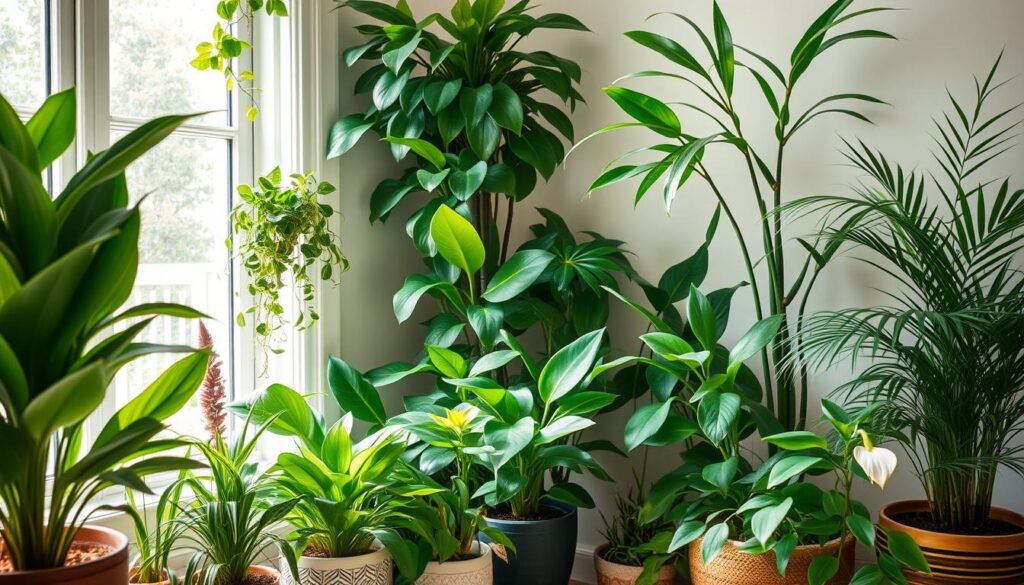
Adding these plants to your home or office improves indoor air quality. They’re low-maintenance and easy to care for. Next, we’ll explore each plant’s unique characteristics and care needs.
Bamboo Palm: Natural Humidifier and Air Cleanser
The Bamboo Palm, known as Chamaedorea seifrizii, is a great indoor plant. It acts as a natural humidifier and air purifier. This plant is perfect for improving air quality and adding a tropical feel to your home.
This plant is great at removing formaldehyde from the air. Formaldehyde is found in many indoor items like furniture and building materials. By removing it, the plant makes the air healthier to breathe.
The Bamboo Palm also helps keep the air moist. This is very helpful in dry, heated spaces. It prevents health problems and protects furniture and electronics from damage.
This plant loves low light, making it perfect for dark spots in your home or office. Its green leaves and bamboo-like stems bring beauty and calm to any room.
| Key Features | Benefits |
|---|---|
| Formaldehyde Removal | Purifies indoor air by filtering out harmful chemicals |
| Natural Humidifier | Helps maintain optimal indoor humidity levels |
| Low-Light Tolerance | Thrives in areas with limited natural sunlight |
The Bamboo Palm is a great choice for improving your indoor space. It purifies the air, adds moisture, and looks beautiful. Adding this plant to your home or office can make the air healthier and the atmosphere more peaceful.
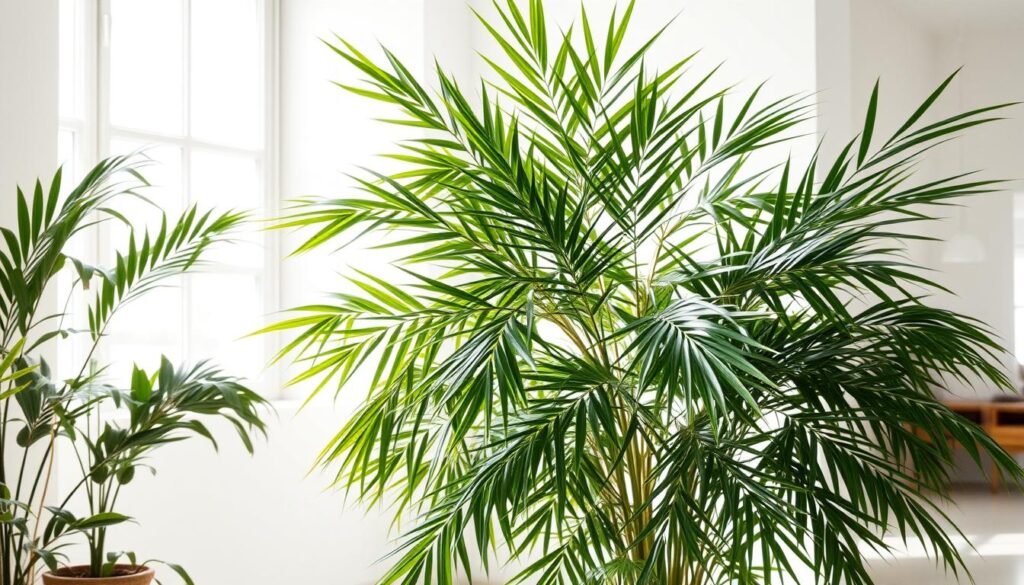
Rubber Plant: The CO2 Converter
The Rubber Plant, known as Ficus elastica, is a top air-purifier. It’s great at taking in carbon dioxide. This easy-to-care-for ficus makes indoor spaces look good and air cleaner.
Light Requirements
The Rubber Plant loves bright, indirect light. It can handle some direct sun but too much can burn its leaves. It’s best in a bright room or near a window.
Watering Schedule
- Water the Rubber Plant when the top inch of soil feels dry.
- Don’t overwater to avoid root rot and other problems.
- In winter, water less to keep the soil from getting too wet.
Growth Patterns
The Rubber Plant grows fast and can get up to 10 feet tall. Its big, shiny leaves help clean the air by removing carbon dioxide through photosynthesis.
This plant is easy to care for and cleans the air well. It’s a great choice for any indoor space.
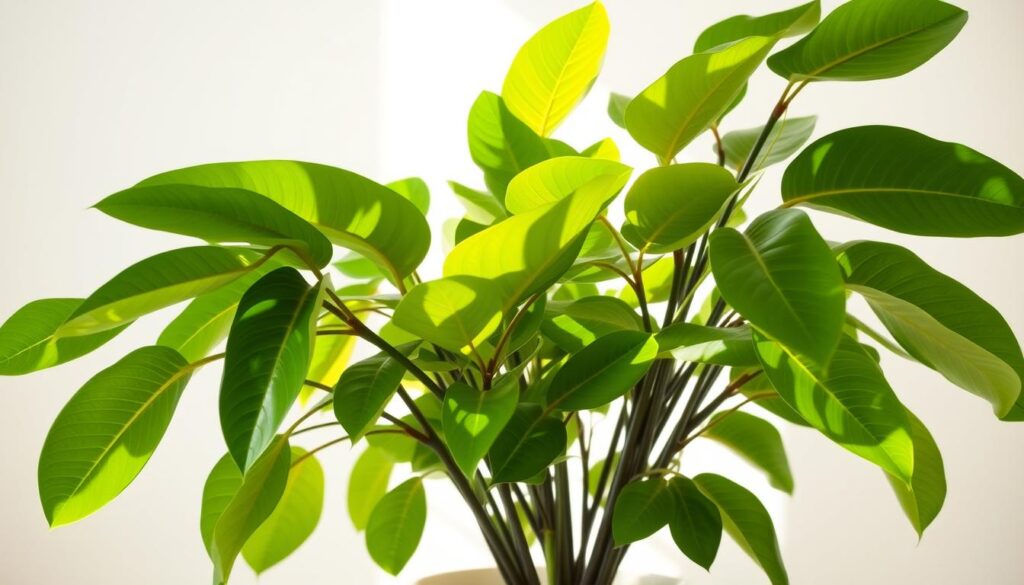
“The Rubber Plant is a true CO2 converter, making it an essential choice for anyone seeking to improve their indoor air quality.”
Boston Fern: Humidity Lover and Air Purifier
The Boston Fern, known as Nephrolepis exaltata, is a standout indoor plant. It loves humid environments and is great at cleaning the air. This green fern is especially good at removing formaldehyde and xylene, common air pollutants.
As a natural air humidifier, the Boston Fern’s big fronds add moisture to the air. This is great for dry indoor spaces, keeping them comfortable and healthy. Its ability to control humidity also improves the comfort and well-being of those around it.
“The Boston Fern is a true multitasker, offering both aesthetic appeal and practical air-purifying benefits in the home.”
The Boston Fern is amazing at removing formaldehyde and xylene from the air. Formaldehyde is found in many indoor items, while xylene comes from paints and cleaning supplies. By filtering out these harmful substances, the Boston Fern makes the air cleaner and healthier.
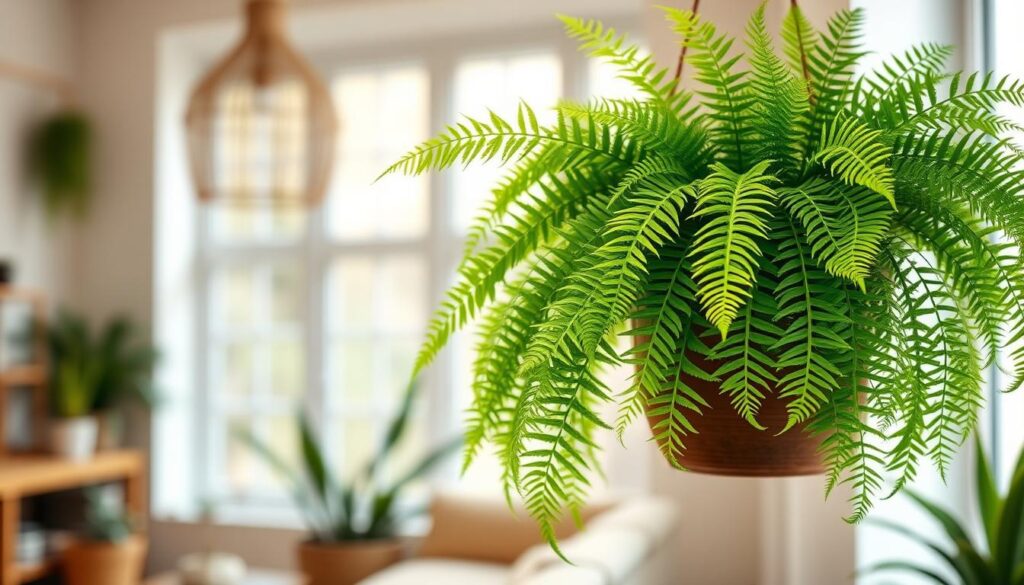
To keep the Boston Fern happy and air-purifying, it needs the right care. It needs plenty of humidity, regular water, and some indirect sunlight. With the right conditions, it will thrive and make your indoor space healthier and more vibrant.
Dracaena: Versatile Air-Cleaning Plant Family
The Dracaena family is a standout in indoor plants. They are known for cleaning the air of harmful toxins like benzene and trichloroethylene. This makes them a great choice for homes and offices.
Different Varieties
The Dracaena family has many species, each with its own look and air-cleaning skills. The Dracaena marginata and Dracaena fragrans are two popular ones. They both clean the air but look different, fitting various tastes.
Care Instructions
- Light Requirements: Dracaena plants do well in medium to bright, indirect light. They’re perfect for spaces with little light.
- Watering: They like well-draining soil and should be watered moderately. Avoid too much or too little water.
- Humidity: Dracaena’s prefer a bit of humidity. Mist their leaves or use a pebble tray to keep the air right.
- Pruning: Cutting off dead or damaged leaves keeps the plant looking good and encourages new growth.
Dracaena plants are great for indoor spaces. They have beautiful leaves, clean the air, and are easy to care for. Choose the Dracaena marginata for color or the Dracaena fragrans for scent. Either way, they’ll make your space better.
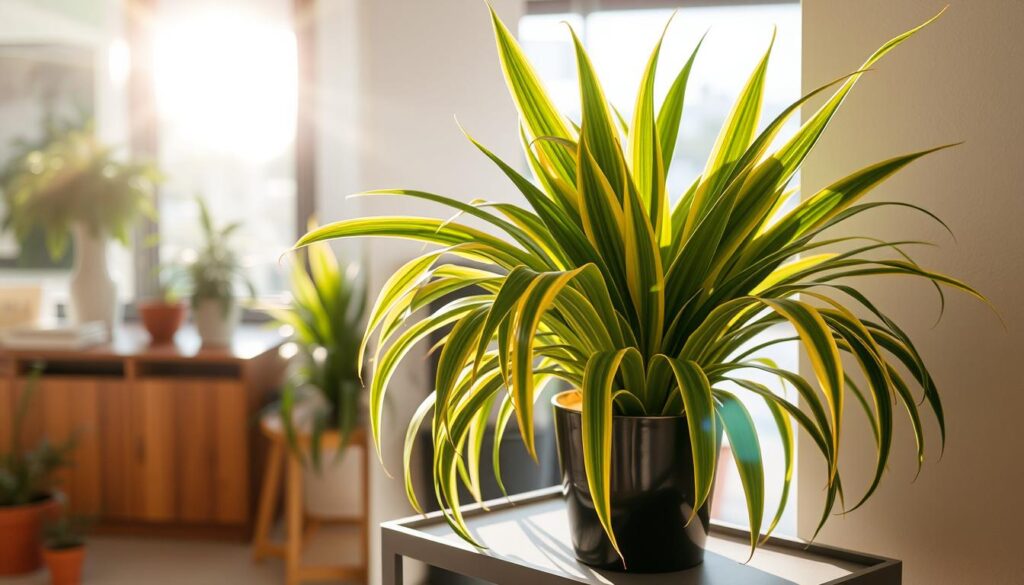
Aloe Vera: Beyond Air Purification
Aloe barbadensis miller, or Aloe Vera, is more than just a plant that cleans the air. It has many uses and is easy to care for. This makes it a great choice for any indoor space.
Aloe Vera is good at removing formaldehyde from the air. A NASA study showed it’s one of the best plants for this. It’s perfect for places like bedrooms and offices.
Aloe Vera is also known for its health benefits. Its gel can help with skin problems like burns and eczema. It’s also good for your digestive health and immune system.
One of the best things about Aloe Vera is how easy it is to care for. It doesn’t need much water or attention. This makes it great for people who are new to plants or are busy.
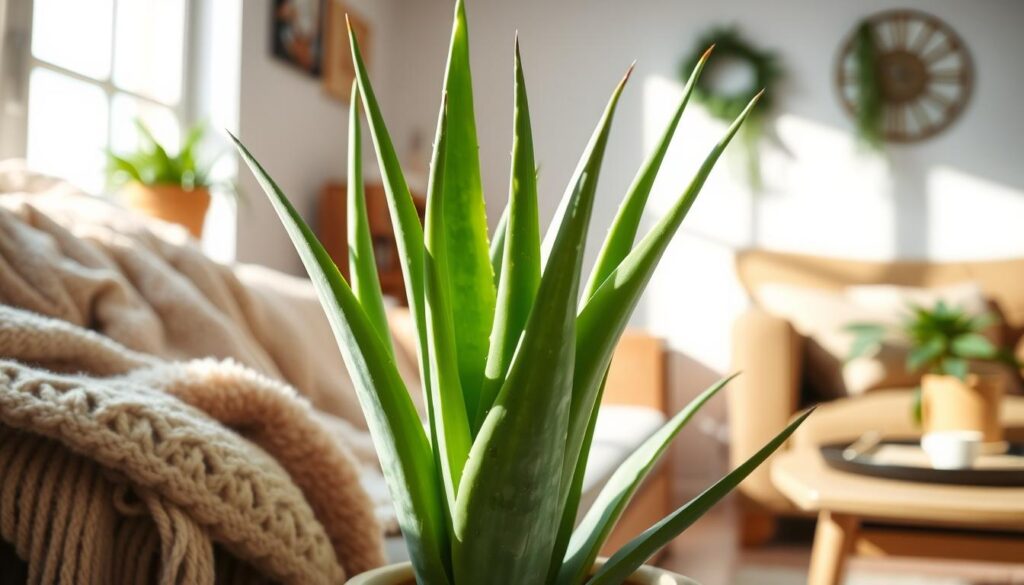
Aloe Vera is great for cleaning the air, improving health, or just because it’s easy to care for. It shows how plants can make our lives better in many ways.
Chinese Evergreen: Low-Light Air Purifier
The Chinese Evergreen, also known as Aglaonema, is a great plant for indoor air. It’s easy to care for and good at removing benzene from the air. This makes it perfect for homes and offices.
What makes the Chinese Evergreen special is how well it does in low light. It can grow well even in places with little natural light.
Placement Tips
Choose a spot for your Chinese Evergreen that gets indirect light. It likes bright light but not direct sunlight. A north-facing window or artificial lighting works well.
Maintenance Guide
- Water the plant when the top inch of soil is dry. Don’t overwater.
- Fertilize every few months with a balanced, diluted fertilizer during the growing season.
- Prune dead or damaged leaves to keep it looking good and encourage new growth.
- Watch for pests like spider mites and mealybugs. Treat any problems quickly.
The Chinese Evergreen is great for improving indoor air. It’s easy to care for and can handle low light. Adding it to your space can make the air cleaner and healthier.
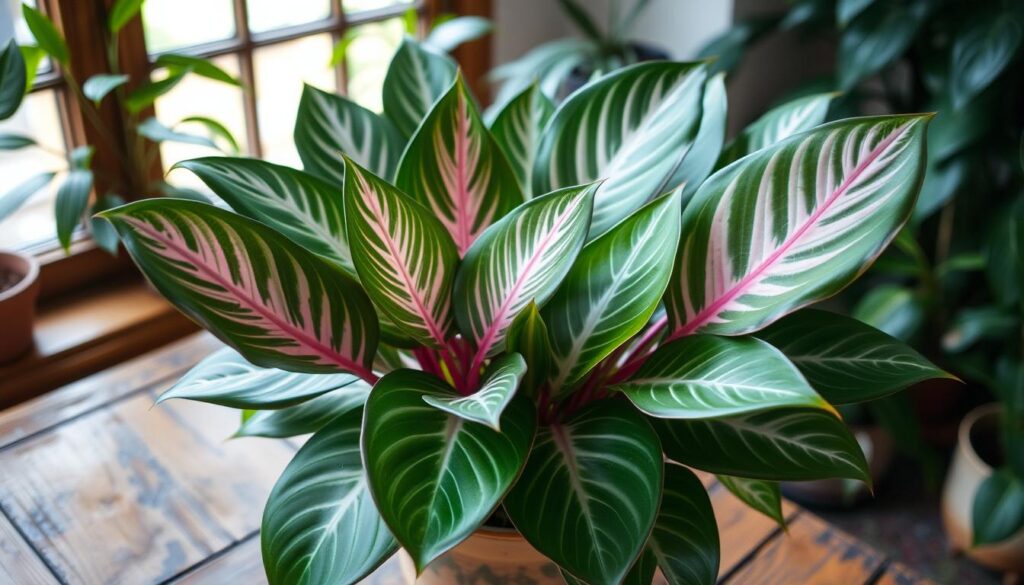
Best Locations for Air-Purifying Plants
Indoor air quality can greatly improve with the right placement of air-purifying plants. Knowing the air purification needs of each room helps create a plant placement strategy. This strategy maximizes the benefits of these natural air filters.
In the living room, choose plants that remove pollutants like formaldehyde and benzene. Spider plants and peace lilies are great here. They efficiently clean the air, improving indoor air quality.
Bedrooms need plants that absorb carbon dioxide and release oxygen at night. The snake plant, or “bedroom plant,” is perfect. It purifies the air even in low light.
Home offices and workspaces benefit from plants that tackle VOCs from electronics and furniture. Dracaena and Chinese Evergreen are good choices. They help create a healthier, more productive space.
In kitchens and bathrooms, choose plants that handle high humidity. Boston ferns and Bamboo palms are great here. They improve air quality and add beauty to your space.
By placing air-purifying plants in the right spots, you can enhance indoor air quality everywhere. This approach ensures each room gets the most from your indoor plants.
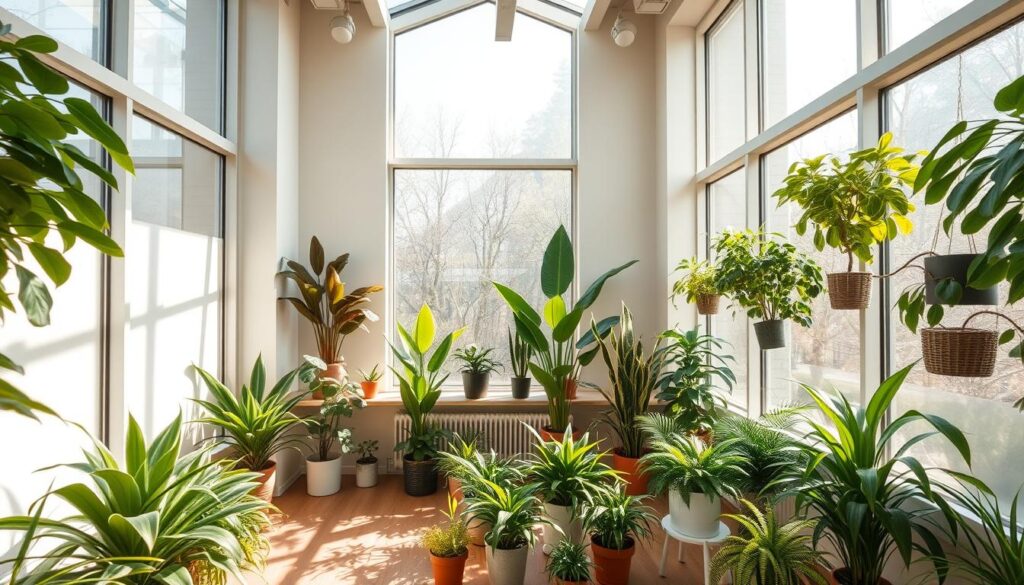
Successful indoor plant placement depends on understanding each room’s air purification needs. By choosing the right plants, you can make your space healthier and more breathable. This promotes your overall well-being.
Common Care Mistakes to Avoid
Keeping your indoor plants healthy and air-purifying needs careful attention. Two big mistakes are watering too much or too little and not giving them the right light.
Watering Issues
Too much or too little water can stress your plants. Overwatering causes roots to rot, while underwatering makes leaves wilt and fall off. It’s key to water them regularly, but not too much.
- Check soil moisture before watering and water only when the top inch of soil is dry.
- Use the “soak and dry” method, allowing the soil to partially dry out between waterings.
- Adjust watering frequency based on factors like plant type, pot size, and environmental conditions.
Light Exposure Problems
Getting the right light requirements is vital for your plants’ health and air purification. Too little light can stunt growth, while too much can burn leaves and slow growth.
- Identify the light preferences of each plant and place them in appropriate locations.
- Rotate plants periodically to ensure even light exposure.
- Monitor for plant stress signs like wilting, yellowing, or discolored leaves, and make adjustments as needed.
Avoiding these common mistakes will help your air-purifying plants stay healthy and effective. This will improve the air in your home.
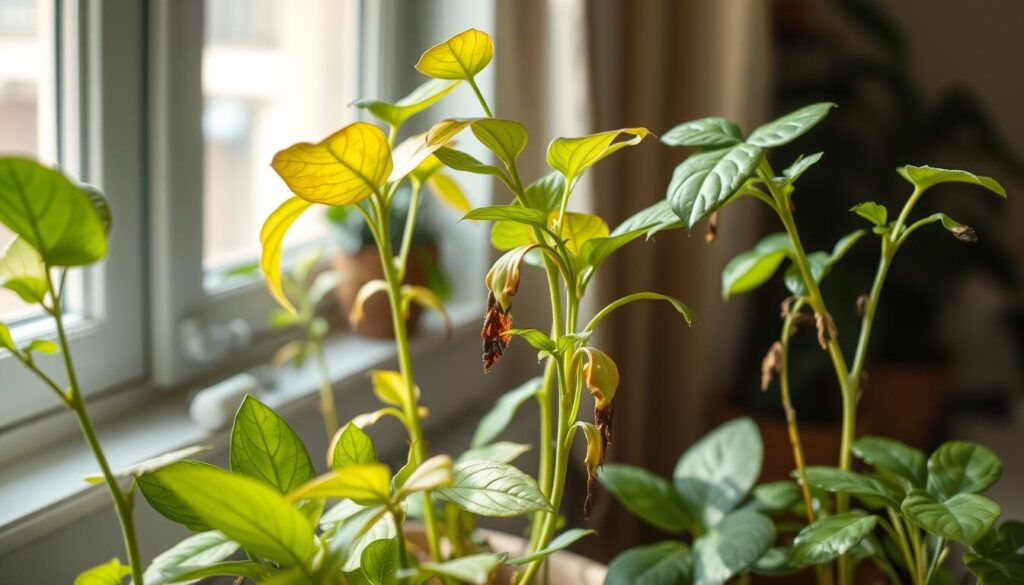
| Watering Issue | Symptom | Impact on Air Purification |
|---|---|---|
| Overwatering | Root rot, wilting leaves | Reduced plant health and air-cleaning ability |
| Underwatering | Dried, drooping leaves | Decreased photosynthesis and air filtration |
Seasonal Care Guidelines
Keeping your air-purifying plants healthy all year round means changing how you care for them with the seasons. In winter, when it’s darker and drier, watch how much water you give them. Water less often to avoid drowning the roots and let the soil dry a bit between waterings.
When summer comes, your plants need more light and water. Move them to spots with indirect sunlight to avoid burning their leaves. Also, water them more often because they lose moisture faster in the heat. Fertilize them during this time to help them grow strong and keep the air clean.
Knowing how your plants grow with the seasons is key to keeping them effective at cleaning the air. Adjust your care to match their needs, so they stay healthy and keep the air fresh all year.
Conclusion
One easy yet powerful technique to make your indoor spaces healthier and cozier is to include air-purifying houseplants. These plants, which range from the easy-care Snake Plant to the adaptable Dracaena family, enhance the aesthetics and practicality of your house or place of business. They enhance air quality with little maintenance by naturally filtering out dangerous pollutants like formaldehyde, benzene, and volatile organic compounds.
To get the most out of these plants, place them in various parts of your house, like living rooms, bedrooms, and work places. They flourish and improve the air quality indoors with proper placement and seasonal maintenance. Your plants will stay healthy and productive if you steer clear of typical maintenance errors like inadequate lighting or watering.
These air-purifying plants provide an easy approach to improve your interiors and increase wellness, regardless of your level of plant experience. Experience the life-changing effects of cleaner, fresher air by starting with a handful of these eco-friendly friends.

